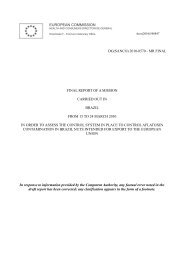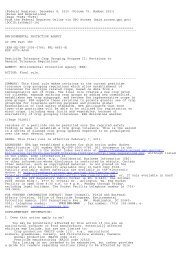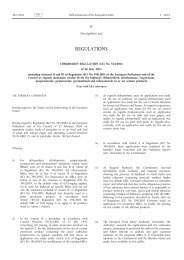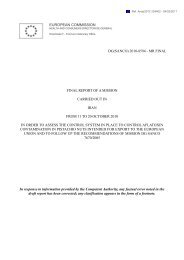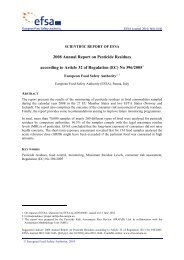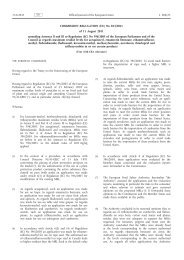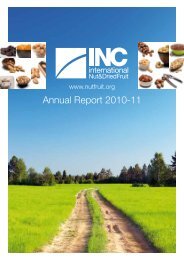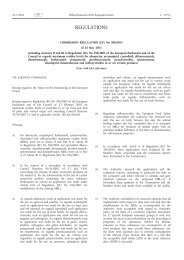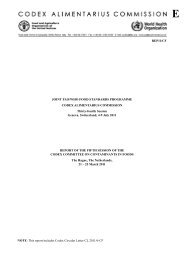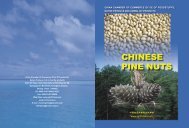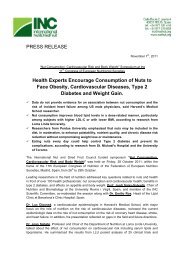REP11/PR JOINT FAO/WHO FOOD STANDARDS PROGRAMME ...
REP11/PR JOINT FAO/WHO FOOD STANDARDS PROGRAMME ...
REP11/PR JOINT FAO/WHO FOOD STANDARDS PROGRAMME ...
You also want an ePaper? Increase the reach of your titles
YUMPU automatically turns print PDFs into web optimized ePapers that Google loves.
<strong>REP11</strong>/<strong>PR</strong> 2<br />
10. In reply to the request from the Committee on Residues of Veterinary Drugs in Foods (CCRVDF), the in-session Working<br />
Group on Methods of Analysis had considered the paper on the development of performance characteristics for multi-residue<br />
analysis methods for veterinary drugs in foods and the Committee agreed with the recommendation of the working group that a<br />
clearly described request and more background information were necessary for making any specific recommendations for discussion<br />
at is future sessions.<br />
REPORT ON ITEMS OF GENERAL CONSIDERATION BY THE 2010 <strong>JOINT</strong> <strong>FAO</strong>/<strong>WHO</strong> MEETINGS ON PESTICIDE RESIDUES<br />
(JM<strong>PR</strong>) (Agenda Item 4a) 4<br />
2.1 Consideration regarding JM<strong>PR</strong> capacity and resources<br />
11. The <strong>FAO</strong> JM<strong>PR</strong> Secretariat gave a brief introduction about the issue of JM<strong>PR</strong> capacity and resources, and suggested that<br />
information in Chapter 2.1 could be helpful when discussing this issue under Agenda item 13(a). The <strong>WHO</strong> JM<strong>PR</strong> Secretariat<br />
informed delegates that in <strong>WHO</strong>, the provision of scientific advice is not supported by the core budget but by voluntary contributions<br />
from member states. He further informed the Committee that <strong>WHO</strong> does not have the secured resources to conduct the JM<strong>PR</strong><br />
related activities in 2012.<br />
2.2 Need for appropriate consumption data<br />
12. The Committee was advised that the JM<strong>PR</strong> assessment of the dietary exposure is a crucial step in the risk assessment<br />
process for pesticides and it can be at the origin of concerns between member states and the Codex Alimentarius. During its last<br />
meeting, the JM<strong>PR</strong> recommended that <strong>WHO</strong> collect new data on large portions to improve the ability for JM<strong>PR</strong> assessment to cover<br />
a wide range of national consumption patterns. The World Health Organization, with the help of its network of Collaborating Centres,<br />
has launched a call to collect these data. <strong>WHO</strong> urged the delegates to follow up on this issue within their respective countries and to<br />
raise the attention of the competent authorities to answer this call.<br />
13. The Committee noted that new data would be provided by Thailand and EU member states. The Delegation of Australia<br />
proposed that a call for data be distributed to ensure that all competent authorities will be informed.<br />
2.3 Update about the GEMS/Food programme<br />
14. The Committee was informed that the GEMS/Food programme aims to collect data on food consumption and on the<br />
occurrence of chemicals in food. A new web based application was developed this year with the support of the US Food and Drug<br />
Administration. This system will allow member states to upload their data directly on the <strong>WHO</strong> website and will also allow the<br />
competent authorities to access the <strong>WHO</strong> database.<br />
2.4 Information on the use of pesticides required for the estimation of residue levels in minor crops<br />
15. The Committee was informed that the 2010 JM<strong>PR</strong> reviewed the residue data on minor crops conducted in a number of<br />
developing countries and submitted by the Pesticides Initiative Programme (PIP). However, no approved label or an official letter<br />
including the authorized GAP was provided from the responsible government agency. The JM<strong>PR</strong> evaluated the submitted residue<br />
data, and conditionally made recommendations for maximum residue levels for some minor crops, leaving the final decision on<br />
acceptance to the CC<strong>PR</strong>. The JM<strong>PR</strong> emphasized that the official use patterns are one of the essential requirements and that data<br />
submitters should comply with the requirements as specified in the <strong>FAO</strong> Manual.<br />
16. The Delegation of Kenya expressed their appreciation to the JM<strong>PR</strong> for its consideration of the need for Codex MRLs to be<br />
established for minor crops and the diverse GAPs in developing countries. The Delegation of Kenya committed to provide the<br />
necessary information on the officially recognized /authorized GAPs, including labels by April, 2011 and suggested advancing the<br />
proposed maximum residue limits.<br />
2.5 Principles and guidance on the selection of representative crops for the extrapolation of MRLs<br />
17. As requested by the 42 nd Session of the CC<strong>PR</strong>, the 2010 JM<strong>PR</strong> reviewed the text of the proposed principles and guidance on<br />
the selection of representative crops for the extrapolation of MRLs to commodity groups and provided further guidance on how it<br />
estimates group maximum residue levels. The JM<strong>PR</strong> commented that the guidance will be particularly useful during the planning<br />
stages of supervised trials to ensure that the residue data will be sufficient to support group MRLs.<br />
18. The Delegation of the EU supported the initiative to establish clear rules for extrapolations, but was not in favour of<br />
extrapolating the highest MRL for the subgroup with the most critical residue situation to the whole crop group.<br />
4 Section 2 of the 2010 JM<strong>PR</strong> Report. Comments from Kenya (CRD 5); EU (CRD 15); and China (CRD 19).



